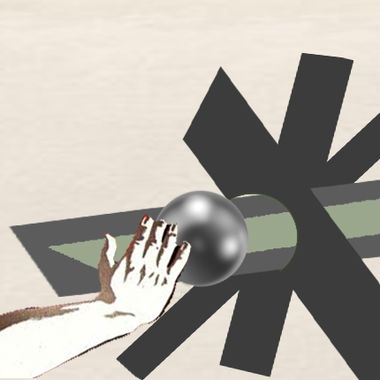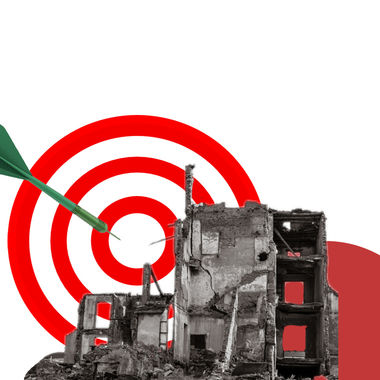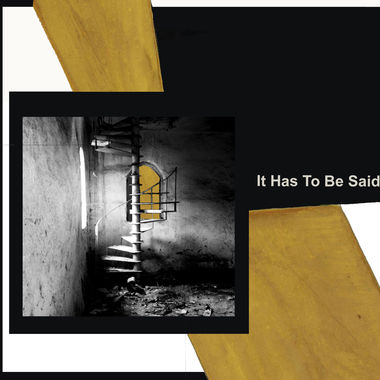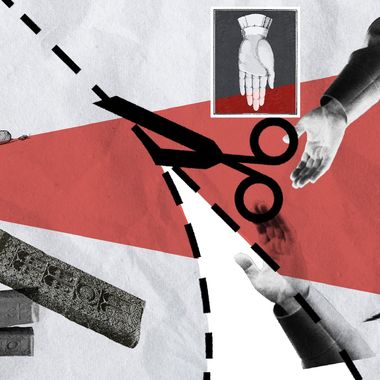Mon Jul 12 2021 · 11 min read
Failure Through Victory: The Paradox of the Tavush Crisis One Year Later
By Lusine Sargsyan , Nerses Kopalyan

Illustration by Armine Shahbazyan
It is the one year anniversary of the Tavush clashes, over which the Pashinyan Government claimed victory, Armenian society extolled the military-readiness of its armed forces and the streets of Baku exploded in protests, demanding war and revenge.
The framing of the Tavush clashes, and the subsequent narrative that was perpetuated in Armenia and Azerbaijan, reinforced what had been an open secret for some time: a diplomatic solution was an illusion, as both societies either glorified the smallest of victories, or claimed victimhood at the smallest of defeats. As a harbinger for the 2020 Artsakh War, the Tavush clashes showed that both societies relished the idea of militarily defeating or punishing the other, that the international community remained silent and irrelevant, that Turkey demonstrated a provocative posture encouraging further Azerbaijani aggression and that Russia remained in its geopolitical comfort zone of dishonest bothsideism. If the Tavush clashes taught us one thing, it was that the glorification of the use of force had become the prevailing principle.
On July 12, 2020, diversionary maneuvers on the eastern Tavush border area by the armed forces of both countries culminated in cross-border violence. Considering the complicated topography of the region, and the strategic positioning on heights of both forces, the matter quickly escalated in a matter of days, bringing about the worst outbreak of hostilities since the 2016 Four Day April War. After internecine clashes in the course of the next week, the situation entered a period of relative calm. The outcome was a tactical victory for the Armenian side, and a positional defeat for Azerbaijan. The death toll from the 11 days of fighting also demonstrated this outcome: the Armenian side suffered five casualties, including two contract soldiers, a major and a captain, while Azerbaijan suffered 11 casualties, including a high-ranking general.
One of the more interesting developments during the conflict was the scope and depth of the frustration that was visible within Azerbaijan’s Defense Ministry. In the midst of fighting, on July 16, Azerbaijani Defense Ministry spokesperson Colonel Vagif Dargahli said that their latest missile systems have the ability to hit Armenia’s Metsamor Nuclear Power Plant with accuracy, threatening that it “could lead to a major disaster for Armenia.” He also claimed that Baku’s modern air defense systems were in place to protect the Mingachevir Reservoir, which he claimed was a potential target for Armenian forces. At that point, Armenia had not targeted any civilian objects nor had it ever claimed that the reservoir was a target. In this context, threats of excessive escalation, or unsubstantiated accusations against Yerevan, were clear indicators of the Azerbaijani Defense Ministry’s inability to sufficiently cope with the crisis in a fashion that was commensurate with Baku’s strategic interests.
To mitigate the absurdities that were being spewed by its Defense Ministry, Hikmet Hajiyev, Assistant to the President of Azerbaijan and Head of the Foreign Policy Department of the Presidential Administration, quickly responded, stating that Azerbaijani Armed Forces never planned to shell Armenian infrastructure of strategic importance, including civilian objects. He also noted that the position of the Defense Ministry’s spokesperson did not reflect Azerbaijan’s official position. This clear disconnect, within an otherwise rigid state hierarchy, remains an important point of observation: Azerbaijan’s Armed Forces were caught off guard by the performance of Armenian troops in Tavush, thus triggering claims and accusations that the political leadership itself found to be excessive and nonsensical.
Armenia’s official position, on the other hand, was quite straightforward: the threats made by Azerbaijan’s Defense Ministry were not only a blatant violation of International Humanitarian Law and the First Additional Protocol to the Geneva Conventions, but also an explicit demonstration of state terrorism and genocidal intent. Considering the fact that a possible nuclear disaster would not only affect Armenia but harm the greater region, including the people of Azerbaijan, the threat demonstrated Azerbaijan’s “absolute absence of responsibility and sound judgement.”
Developments in Azerbaijan
Amid the escalation of the situation on the border, on July 14, a massive rally broke out in Baku, where tens of thousands of Azerbaijanis were calling for outright war with Armenia, chanting “End the quarantine, start the war!” Some protesters even forced their way into the Parliament building, after which security forces dispersed the crowds with water cannons and tear gas. Considering the rarity of such protests in Azerbaijan, especially the rigid control that the security apparatus exercises in suppressing public discontent, one could deduce that this massive rally was, at least in its initial stages, tacitly condoned by the governing elite. It was an attempt at displaying a collective war spirit, a sense of justification for the war rhetoric of the Aliyev regime, but portraying it as grassroots and bottom-up. Namely, the narrative was that it wasn’t the political elite that were calling for war, but rather the angry and victimized Azerbaijani society, an organic force demanding retribution against Armenia. That the rally got out of control is quite interesting, but the subsequent response by security forces confirmed the suspicions of most observers: the rally was to be undertaken within certain parameters that served the interests of the regime, but once these parameters were violated, the response by the security apparatus was swift and rigorous.
During this specific period, Azerbaijan’s long-serving Foreign Affairs Minister Elmar Mammadyarov, who had been in that role since 2004, resigned and was replaced by the country’s Education Minister Jeyhun Bayramov. Mammadyarov’s resignation came after Aliyev strongly criticized the country’s diplomatic efforts and stressed that diplomacy should be offensive and not passive or defensive. Aliyev also expressed his dissatisfaction with the fact that Mammadyarov discussed cooperation with Armenia in the fight against the coronavirus pandemic. The overall trend was against diplomatic solutions and instead leveraging diplomacy to justify and reinforce a solution through military force. Mammadyarov’s removal remains one of the more important indicators of this growing policy shift within Baku: the time for talking appeared to be over, and the call to arms had begun.
This became quite evident when assessing, prior to the escalation of the Tavush crisis, the rhetoric of President Aliyev. He was clearly signaling that he was willing to shift from a diplomatic solution to a military one. On July 7, 2020, a few days before the escalation of the situation on the border, Aliyev expressed his dissatisfaction with the OSCE’s Minsk Group Co-Chairs’ format for peace negotiations, calling video conferences between Armenian and Azerbaijani leaders “meaningless.” He also noted that Azerbaijan may refuse to participate in any continuing negotiations over the Nagorno-Karabakh conflict. In an interview, Aliyev specifically noted that Azerbaijan will not change its position regarding the peace process, because Baku’s demands were “fair” and that their position remains hinged on historical justice and international law. He was particularly opposed to the return of representatives of the Republic of Artsakh as a direct party at the negotiating table, which Armenia’s Prime Minister Nikol Pashinyan has been pushing for since his election in 2018.
International Community Response
Turkey
Throughout the July clashes, Turkey issued several statements declaring its unwavering support for Azerbaijan and its readiness to engage in the conflict on the Azerbaijani side. Ankara’s position was quite unequivocal: Turkey was not a stabilizing force, but rather a de-stabilizing one driven to advance Azerbaijan’s interests at any cost. In fact, Turkey was the only country that was directly provoking the situation, encouraging increased military action, as opposed to de-escalation and a peaceful resolution. At the time, PM Pashinyan confirmed that Turkey's tactics of provoking regional destabilization remained extremely worrisome, adding that it was best reflected in the official announcements of the Turkish Foreign Ministry.
In its official announcement, Turkey’s Foreign Ministry referred to the area of conflict as Azerbaijan’s “Tovuz region,” and condemned Armenia for attacking what it qualified as Azerbaijani lands. The statement called the attack a manifestation of Armenia's aggressive nationalism and a way to distract the attention of the international community from Nagorno-Karabakh. To further support Baku’s belligerent behavior, Turkey clearly stated that the country’s military-political leadership stood by Azerbaijan in its struggle to protect its territorial integrity.
On July 17, 2020, Turkish President Recep Tayyip Erdogan, speaking to journalists, began providing Baku diplomatic and political cover by justifying Azerbaijan’s behavior and tying the developments in Tavush to Nagorno-Karabakh. Erdogan initially stated that Armenia is an occupying force and has been for decades, although this assertion had nothing to do with the Tavush crisis. Further, Erdogan stated that the OSCE Minsk Group has left the issue pending for 25-30 years, and the inability of the international community to solve this issue was what led developments to reach the current point. “Armenia is continuously shooting at civilian regions of Azerbaijan and, as a result of these attacks, Azerbaijan is doing what it should do when it comes to protecting its own territory or people.” Framing Azerbaijan as a victim of Armenian aggression and occupation, Erdogan asserted that Turkey will not abandon its brother Azerbaijan.
As developments were transpiring, a delegation from Azerbaijan arrived in Turkey and held meetings with Turkey's Minister of Defense and Chiefs of the Armed Forces. After receiving the commander of the Azerbaijani Air Force and Deputy Defense Minister Ramiz Tahirov in Ankara on July 16, 2020, Turkish Defense Minister Hulusi Akar said Armenia was responsible for starting military operations on the border with Azerbaijan, and that Armenia would be “drowned under the plot that they initiated.” Akar told reporters, “The pain of the Azeri Turk is our pain,” and that Turkey “condemns this villainous attack,” adding that “the blood of Turkey’s Azerbaijani brothers will not remain unavenged.” On July 17, 2020, following a meeting with Azerbaijani Deputy Defense Minister Ramiz Tahirov and Army Commander of the Nakhchivan Autonomous Republic Kerem Mustafayev, İsmail Demir, the head of the Presidency of Defense Industries, an affiliate of the Turkish Presidency, tweeted that Turkey’s armed unmanned aerial vehicles, ammunition and missiles, along with the required experience, technology and capabilities are at Azerbaijan’s service. The Turkish takeover of the Azerbaijani Armed Forces appeared to have been in full swing, and it was the Tavush crisis that catapulted a further crystallization of the Turkification of Azerbaijan’s military.
Russia
Whereas Turkey displayed unvarnished support to its military ally Azerbaijan, Russia’s position toward its military ally Armenia was neither unwavering, nor one of support. Rather, the Russian position was one of incoherent neutrality, a dishonest both-sideism that was more defined by Russia serving its own interest vis-a-vis Azerbaijan, as opposed to protecting or advancing the interests of its ally Armenia. Whereas Turkey’s support was one-sided and commensurate with its treaty obligations, Russia’s was more driven by maintaining parity and balance in the South Caucasus, as opposed to fulfilling its treaty obligations. This became fairly evident when Armenia, against the backdrop of Azerbaijan’s military aggression, did not request additional arms deliveries from the Russian Federation and also did not invoke Article 2 of the Collective Treaty Security Organization (CSTO), which would have committed member states to immediately launch the mechanism of joint consultations when a member state is faced with a menace to safety, stability, territorial integrity and sovereignty. There was a tacit understanding that the CSTO would not interject itself into this conflict, or any conflict involving Armenia and Azerbaijan, and furthermore, the CSTO was not designed to serve the needs of its members, but rather, to serve the broader geostrategic interests of Russia against NATO. In this context, the Russian position was driven by broader geopolitical considerations, while Turkey’s position was driven by specific bilateral considerations.
The outcome was the strengthening of the Azerbaijani position through the support it received from its regional patron, and the weakening of Armenia considering the relative indifference of its regional patron. When correlating the Tavush crisis with the most recent developments concerning the border incursions by Azerbaijan in the Syunik and Gegharkunik regions, and comparing it to Russia’s and the CSTO’s response to the Tavush crisis, the thematic posture remains the same: the CSTO refuses to accept Armenia’s appeals, while Moscow maintains a posture of both-sideism. The statements issued by the Russian Ministry of Foreign Affairs reconfirmed its neutral posture, as it expressed serious concern about the escalation, noted how the situation threatened the security of the region, how this was unacceptable to Russia, and urged both parties to the conflict to show restraint and adhere strictly to the ceasefire regime. To this end, whereas Turkey’s statements were inherently Azerbaijani-centric, Russia’s statements were not, by any stretch of the imagination, Armenia-centric, but rather, remained inherently Russia-centric.
Conclusion
The Tavush crisis was a double-edged sword for Armenia, one that brought about much hope within the public psyche about the strength and abilities of its armed forces, yet one that also revealed the diplomatic failures and regional isolation of Armenia. For Azerbaijan, the Tavush crisis was a continuation of its decade-long policy of hybrid incursions, grey zone tactics, and selective intensification of cross-border violence. The more important takeaway when observing the crisis one year after the fact appears to be the following: for Azerbaijan, the Tavush crisis was the continuation of a larger grand strategy, while for Armenia, it was an isolated incident that was dealt with on an ad-hoc basis. Overarchingly, Armenia failed to cogently understand its shortcomings in the aftermath of the crisis, but rather, only chose to concentrate and extol its relative victory. Azerbaijan, on the other hand, cogently grasped its shortcomings, and turned to Turkey for solutions. What we saw in the months after was the enhancement of Azerbaijani-Turkish engagements, from war games to diplomatic cooperation and coordination. What we saw with Armenia, on the other hand, was more of the same: frustration with Russia, artificial boasting of military prowess, and an inability to expand diplomatic efficacy. Perhaps with the one year anniversary of this crisis, the lessons that were not learned can now be re-learned by the newly-elected government, and the shortcomings that have been inherent to Armenia’s failed policies of the last 30 years can undergo a paradigm shift. If not, Armenia will remain stuck with more of the same… and the consequences will also be more of the same.
Also Read
If You Seek Peace, Prepare for War: Armenia’s Security Dilemma and the Need for a New Defense Doctrine
By Nerses Kopalyan
Armenia’s security infrastructure requires a robust defense doctrine, expansive reforms, rearticulation of geopolitical and geostrategic realities, closing the gap in power disparity with regional actors and competent institutional structures.
When Civilian Populations Come Under Fire
By Astghik Karapetyan
When the situation on the Armenia-Azerbaijan state border escalated on July 12, 2020, Armenian civilian settlements came under fire for days, a violation of international humanitarian law.
It Has To Be Said: Living on the Border
By Maria Titizian
Border settlements are unequivocally and strategically vital for the security of Armenia and Artsakh. Protecting them militarily, economically and socially needs to be a national priority.
Azerbaijan’s Anti-Armenian Policies Before the Artsakh War
By Lusine Sargsyan
Although the severity of war crimes committed by Azerbaijan and its disregard for international humanitarian law was unprecedented during the 2020 Artsakh War, it is a continuation of official Baku’s anti-Armenian policy stretching back over a century.
The Fall and Rise of Myths in Post-War Armenia
By Garen Nazarian
Several popular myths that had become deeply entrenched in Armenian society began collapsing after the war. Today, new myths are being constructed. Will Armenians risk fooling themselves into disingenuous politics and disastrous policy based on a set of new myths?
Podcasts
After Azerbaijani forces began shelling Armenian positions on the international border between the two countries on July 12, Azerbaijani hackers launched cyber attacks on a number of Armenian state and media websites and vice versa. Digital security consultant and co-founder of CyberHub Artur Papyan explains the logic, history and potential danger of this hybrid warfare.
Bishop Bagrat Galstanyan, the Primate of the Diocese of Tavush speaks about the strength, patriotism and resilience of the people living in the border villages and towns along the Armenia-Azerbaijan state border. He says the imperative is to develop and strengthen infrastructure and institutions in Tavush and it is the responsibility of the Armenian nation to support them through investments and not only charity.
Inga Harutyunyan is the founder and executive director of Pahapan Development Foundation that implements sustainable projects in borderline regions, primarily in Tavush, to ensure economic prosperity, welfare and safety. She spoke about a number of their projects, including building playground shelters for children. Harutyunyan is also the advisor to the Governor of Tavush and explained how their model of coordinating development aid to mitigate overlaps and duplication has led to more efficient delivery of services.








